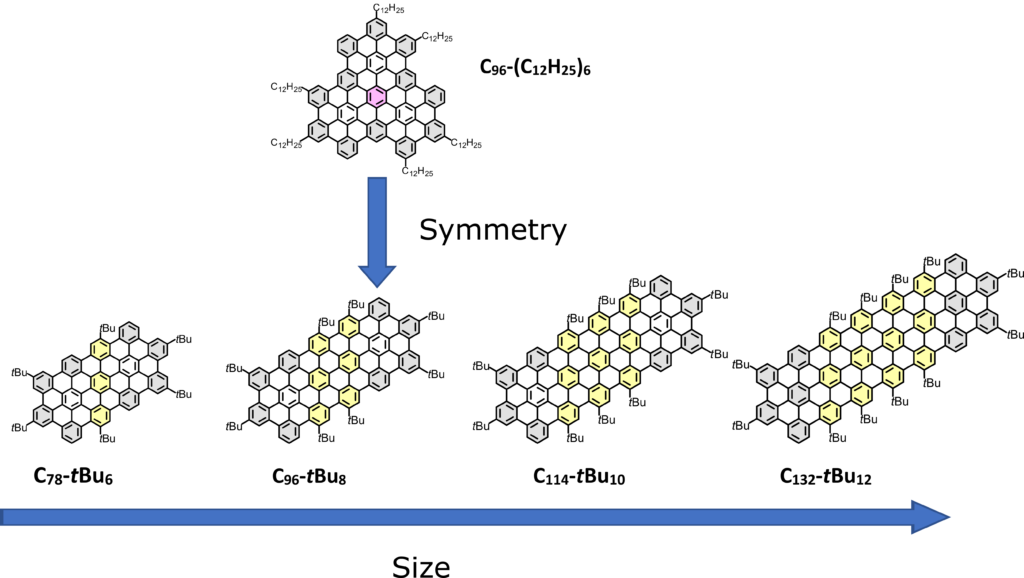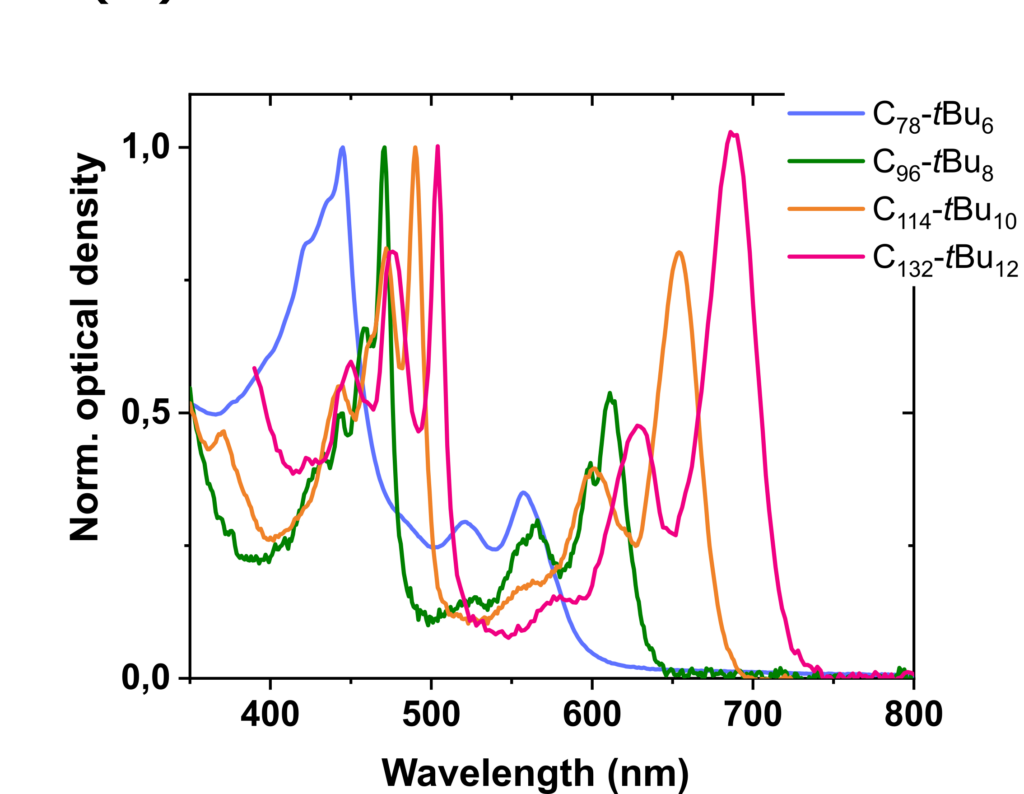We are currently working on the photophysics of graphene quantum dots synthesized by bottom-up chemistry. In particular, we investigate how their size and symmetry influence their optical properties. Figure 1 shows several structures that we looked at recently. Starting from a structure with 96 sp2 carbon atoms in a D3h symmetry, the symmetry has been decreased to D2h; then the size has been varied.

Figure 1: Several structures of GQDs with different sizes and symmetry

Figure 2: Optical absorption spectrum of several GQDs.
We perform experiments at the single GQD level, as illustrated at the top of Figure 3. The measurement of the second-order correlation function (inset of Figure 3) ensures that a single GQD is indeed under study. We perform experiments at room and low temperatures, particularly to study the electron-phonon coupling in these systems.
Current interests:
We want to investigate the evolution of the exciton’s spatial coherence with the molecule’s size to highlight the giant oscillator strength effect. We also aim to control the local environment of the GQD to reach emission with a lifetime limited linewidth at low temperatures. Finally, the elongated GQDs show strong transition dipoles (up to 16D for those available). We want to use this property to build arrays of entangled dipoles.
As an illustration, Figure 2 shows that the energy of the optical transitions can be tuned by more than 100 nm depending on the structure. The high fluorescence quantum yield (>90%) makes GQDs promising as light emitters. Likewise, one observes that the ratio between the first transition intensity and the second one increases with the length of the GQD. The theory shows that the first transition is polarized along the main axis of the GQD (the one that is increased), whereas the second transition is polarized in the perpendicular direction, which remains unchanged.

Figure 3: (top) Spatial map of GQD/polystyrene guest-host sample. (bottom) Spectrum of a single GQD at room (orange) and 7K (blue).
Recent publications on these topics:
“Interplay of structure and photophysics of individualized rod-shaped graphene quantum dots with up to 132 sp² carbon atoms”, Daniel Medina-Lopez, Thomas Liu, Silvio Osella, Hugo Levy-Falk, Christine Elias, Pranav Ticku, Loïc Rondin, Bruno Jousselme, David Beljonne, Jean-Sébastien Lauret and Stephane Campidelli, Nature Communications 14, 4728 (2023)
“Investigation of Rod-Shaped Single-Graphene Quantum Dot”, Hugo Levy-Falk, Océane Capelle, Thomas Liu, Daniel Medina-Lopez, Emmanuelle Deleporte, Stéphane Campidelli, Loïc Rondin, Jean-Sébastien Lauret, Physica Status Solidi b 260, 2300310 (2023)
“Bottom-up synthesis, dispersion and properties of rectangular-shaped graphene quantum dots” Julien Lavie, Van Binh Vu, Daniel Medina-Lopez, Yannick Dappe, Thomas Liu, Loïc Rondin, Jean-Sébastien Lauret, Sylvain Latil and Stéphane Campidelli, Helvetica Chimica Acta 10.1002/hlca.202300034
“Vibronic fingerprints in the luminescence of graphene quantum dots at cryogenic temperature” Thomas Liu, Baptiste Carles, Christine Elias, Claire Tonnelé, Daniel Medina-Lopez, Akimitsu Narita, Yannick Chasagneux, Christophe Voisin, David Beljonne, Stéphane Campidelli, Loïc Rondin, and Jean-Sébastien Lauret, Journal of Chemical Physics 156, 104302 (2022)
“Vibronic effect and influence of aggregation on the photophysics of graphene quantum dots” Thomas Liu, Claire Tonnelé, Shen Zhao, Loïc Rondin, Christine Elias, Daniel Medina-Lopez, Hanako Okuno, Akimitsu Narita, Yannick Chassagneux, Christophe Voisin, Stéphane Campidelli, David Beljonne, and Jean-Sébastien Lauret, Nanoscale, 14, 3826 – 3833 (2022) “Single photon emission from graphene quantum dots at room temperature”
Shen Zhao, Julien Lavie, Loïc Rondin, Lucile Orcin-Chaix, Carole Diederichs, Philippe Roussignol, Yannick Chassagneux, Christophe Voisin, Klaus Müllen, Akimitsu Narita, Stéphane Campidelli and Jean-Sébastien Lauret, Nature Communications 9, 3470 (2018)